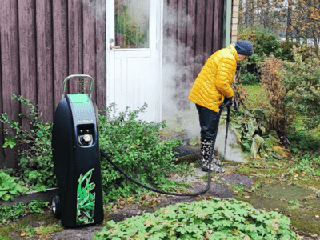The advantages of Thermal Weed Control over Chemicals
Many people are looking at thermal weed control as a possible replacement to chemical pesticides. Here's what you should know.
Chemicals and Thermal products work in a different way
The first thing to understand about the differences between chemical and thermal methods for killing weeds is how they work.
Once this is understood, we can adjust the way the method is used to maximise the benefits.
Thermal weed control works by congealing the chloroplast in the plant. Essentially doing the same job as cooking it.
When the weed is cooked, it loses it's structure and the ability to potosynthesise. Therefore it has no way to produce new energy and it dies.
Some thermal methods are only able to affect the stem and leaves of the plant, whilst other methods are able to cook the roots too. This depends on whether the method can penetrate the soil sufficiently and with enough heat to kill the plant. In general, hot water will work better in penetrating the soil than air, and therefore has a longer lasting kill than hot air with perennials, whereas both will work well on annuals and mosses.
The bigger the plant, the more exposure to heat it will require to achieve the desired kill. Heat will work on anything from a germinating seed, up to a large plant, but a larger plant requires more treatment than a small plant.

How can we maximise efficiency of thermal weed control?
Taking the above into account, it makes sense to try and reduce the number of plants with deep root systems we need to treat, and also to reduce the overall size of the plants we are trying to kill. We can do this easily by taking a few simple steps.
- Firstly, we can alter conditions to favour thermal treatments. This can be done by removing soil from hard surfaces, mulching in flower beds, or planting weed suppressing ground cover along fence lines or around trees. This greatly reduces the number of weeds that need deeling with, and can often have a large impact on the types of weeds, greatly restricting perennials and deeper rooted plants that are more difficult to treat with heat.
- Secondly, we can treat plants much earlier in their life cycle. The earlier we treat a plant, the smaller it is, and therefore the less energy it takes to kill and the less likely it is to regrow from stored energy in it's roots.
- Thirdly, we can choose more efficient forms of thermal control to minimise fuel and energy consumption.

What are the major advantages of Thermal Products over Chemicals when properly used?
- Thermal products are far less weather dependent, so there is no risk of pollution from run off or drift
- They don't require any special licenses to use, so more people can utilise the equipment
- You don't need to comply with the strict rules surrounding chemical sttorage, registration, OCR etc and risk a visit from HSE
- There is less PPE requirements to use these products safely
- Plants cannot build up a resistance in the same way as they can with chemicals
- It is less likely to damage surrounding vegetation
- The public are allowed into contact with it immediately after application
- The public image of thermal products is far better than plant protection products
More information on Thermal Weed Management can be found here;
https://kerstenuk.com/kersten-weed-burners-and-thermal-weed-management
No comments yet. Login to start a new discussion Start a new discussion